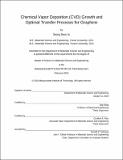Chemical vapor deposition (CVD) growth and optimal transfer processes for graphene
Author(s)
Jo, Seong Soon
DownloadFull printable version (2.522Mb)
Alternative title
Chemical vapor deposition growth and optimal transfer processes for graphene
CVD growth and optimal transfer processes for graphene
Other Contributors
Massachusetts Institute of Technology. Department of Materials Science and Engineering.
Advisor
Jing Kong and Caroline A. Ross.
Terms of use
Metadata
Show full item recordAbstract
Graphene has been regarded as a good candidate to make a breakthrough in various applications including electronics, sensors and spintronics due to its exceptional physical properties. To realize those practical applications, a high quality homogeneous wafer-scale graphene is required. Among various synthesis methods, chemical vapor deposition (CVD) has been a focus of attention as the most promising and cost-efficient deposition techniques, with advantages of its excellent repeatability and controllability, to produce large area graphene crystals on transition metal catalyst substrates. In particular, Cu with low carbon solid solubility is suitable to obtain uniform single layer deposition of graphene over large areas. Here, we report reliable method to grow high-quality continuous graphene film by CVD. Their surface properties and electrical transport characteristics are explored by several characterization techniques. In CVD process, furthermore, a subsequent transfer process to a substrate of interest is required for a wide variety of applications, especially in electronics and photonics, because the metal substrates necessary to catalyze the CVD graphene growth cannot be used. It is important not only to improve quality of as-grown graphene by optimizing growth system but also to develop transfer methods to prevent degradation in quality while transferring as-grown graphene to target substrates. In the case of wet transfer, surface tension of the liquid such as an etching agent or water contributes to make inevitable ripples, wrinkles and cracks. In this regard, we demonstrate new transfer methods by selecting a new polymeric support materials in order to reduce the number of winkles, defects and residues.
Description
Thesis: S.M., Massachusetts Institute of Technology, Department of Materials Science and Engineering, 2018. This electronic version was submitted by the student author. The certified thesis is available in the Institute Archives and Special Collections. Cataloged from student-submitted PDF version of thesis. Includes bibliographical references (pages 48-50).
Date issued
2018Department
Massachusetts Institute of Technology. Department of Materials Science and EngineeringPublisher
Massachusetts Institute of Technology
Keywords
Materials Science and Engineering.